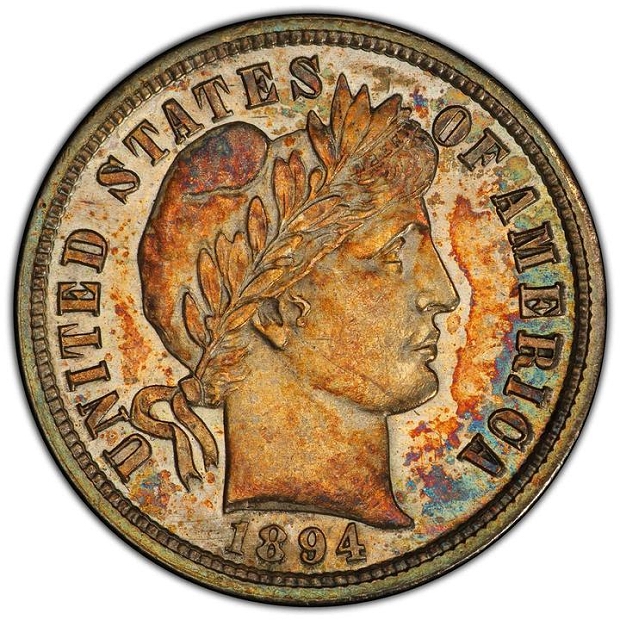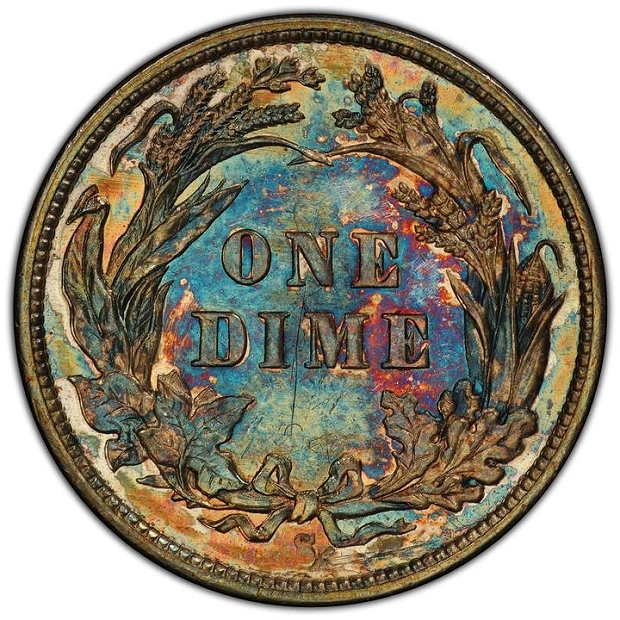The backstory of the 1894-S Barber Dime by Harvey Stack – Co-Founder, Stack’s Bowers Galleries ……
When one goes looking into numismatic history to try to find a pedigree for a rare U.S. coin, one soon discovers that many a record is lost.
But I have recently learned something new about the origin of the 1894-S Barber dime in our upcoming sale at the ANA World’s Fair of Money that gives it a somewhat romantic history that has rarely been discussed.

The story starts with Joseph H. Clapp in the early 1800s, who was an avid collector of rare and unusual coins. He was born in 1831 and died in 1861. He left a son, John H. Clapp, Jr., as his heir, who also became a great collector of coins. John H. Clapp, Jr. lived to be 90 years old and died in late 1939.
John H. Clapp, Jr. was an active collector and added many coins to his father’s collection. He dealt directly with the United States Mint as new issues were released, and in many cases had more than one sent to him for his collection (keeping the best looking one for his primary collection). He bought Proof Sets in all metals and wrote to the branch mints like San Francisco, New Orleans, Carson City, and later Denver, to acquire new issues as they became available. Since he lived in Washington, D.C., he would travel to Philadelphia to acquire new issues in Proof and Mint State for his collection.
After he passed away, the executor of his estate sought out professional dealers to bid on his collection. Stack’s became the winner of the entire collection in 1941-42. Having a great client base, we approached several collectors who had the capital to buy part of or the entirety of the collection. We enjoyed a close relationship with Louis E. Eliasberg, a commercial banker from Baltimore who was a dedicated buyer and collector of U.S. gold coins when we first met him in the late ’30s.

After my father Morton and Uncle J.B. (as he liked to be called) acquired the Clapp collection, they offered it to Eliasberg. He was delighted to have it offered to him due to its completeness and high quality. Plus, he could rest easier knowing that he was in conformity with recent executive orders and Gold Acts that forbade the private ownership of gold coins with no numismatic value. Eliasberg leveraged the secure legal status of his newly expanded collection to further increase and upgrade his coins and it worked until the day he died. His estate, which was managed by his two sons, had no difficulty selling the duplicates and eventually the core collection at private auction.
The background of this is, we have to go back to the Clapp Collection for reference. Joseph H. Clapp had a number of duplicates, including two 1894-S Barber Dime. Stack’s bought the Clapp Collection for $100,000 (a huge sum at the time) and sold it directly to Eliasberg for $110,000. The sale of the collection established a great and longtime friendship between Eliasberg, my father, and my uncle, and Eliasberg relied on them to work towards completing the collection.
During World War II, the value of numismatic coins started to rise, and the postwar economic boom enabled more people to partake in collecting.
Louis E. Eliasberg being a businessman and banker, realized that his investment in the Clapp Collection had risen in value, and he called my father after the war and said, “Morton, the value of what I own in numismatics has grown considerably, and in fact, the various duplicates I have could probably return to me my original investment, so why don’t you and J.B. come down to Baltimore and take out the duplicates, select the best ones for sale, and prepare to sell it at auction?”
My father and uncle did just that, and a selection occurred, with Eliasberg at first planning to keep the slightly lower grades. When Louis asked them what the better coins were worth, both Stacks said the better ones would no doubt recover your initial investment yet the difference between what we selected and you keeping a lesser coin would not be so much. Louis, in his usual flamboyant voice, cried out “Then we will sell the better ones, so I can surely recoupe my original cost”. Regardless of how Stack’s try to convenience him, he said, “please do as I say,” and as it was related to me, “You do not fight with Eliasberg, for he always feels he is right!”
So we had to find a way to offer the duplicates from the collection, and yet not reveal that they came from the now world-class, highly publicized Eliasberg Collection. So after my father and uncle thought about it for a while, they suggested calling the collection the H.R. Lee Collection!
The pseudonym was constructed as follows: “H” and “R” were the pre-marital initials of his wife, and LEE was naturally an acronym of Louis E. Eliasberg. So that is how the pedigree became into existence.
Eliasberg had the 1894-S Barber Dime in duplicate, as well as the 1875 $3.00 gold coin, and they were part of the collection sold in 1947 by Stack’s.
Now on to the pedigree.
F.S. Guggenheimer was another important client and good friend of Stack’s. He attended many of our sales and was successful in acquiring rarities from them. He is known to have bought both the 1894-S Barber Dime and the 1875 $3.00. After Mr. Guggenheimer passed away in 1963, Stack’s was appointed the auctioneer of his collection in his will. We did a special name catalog for him. Besides being able to have the 1894-S as a leader, we also had the 1875 $3.00. But while scanning the catalog, besides these two rarities (and in a separate section), we found the 1823 Proof 25 cents, the 1827 Proof 25 cents, the 1876-CC 20 cents, and the 1838-O half dollar. Though no pedigree was listed it is very likely that one or all were acquired by Guggenheimer, for he was a major buyer at the Lee sale. All the Stacks, including myself, dealt with him and assisted guiding his purchases.
To give you an idea about price values at auction in 1963, none of the above realized less than $2,000 each, and the 1838-O fetched a “whopping” $3,400. If you can think of the values of these rarities today, as well as the other “more common” coins that were also sold, you can see why many of these old-timers whom we had the pleasure of serving and selling for set their numismatic endeavors on a pedestal for a long hold, and a source of pleasure.





I have been a Barber dime collector all my life. Remember a 1894 s being offered for $30,000 did not move on it. Was that in the 50s? Always wanted —just to be close to one. Thanks GG